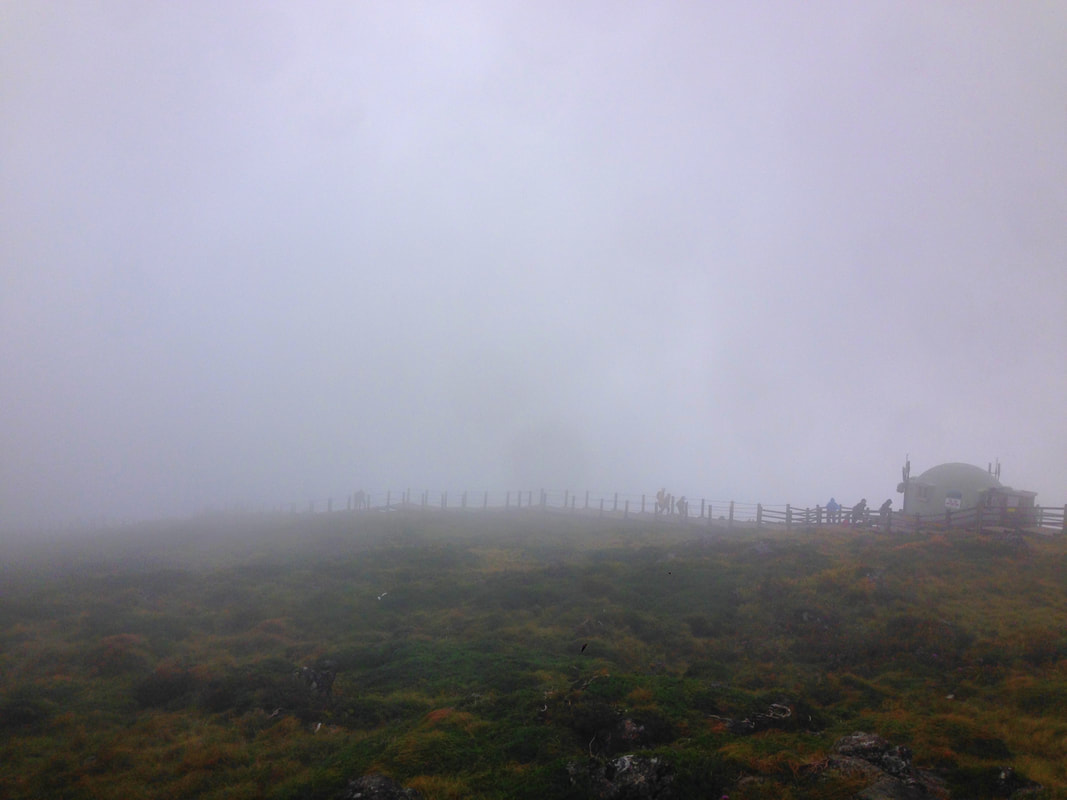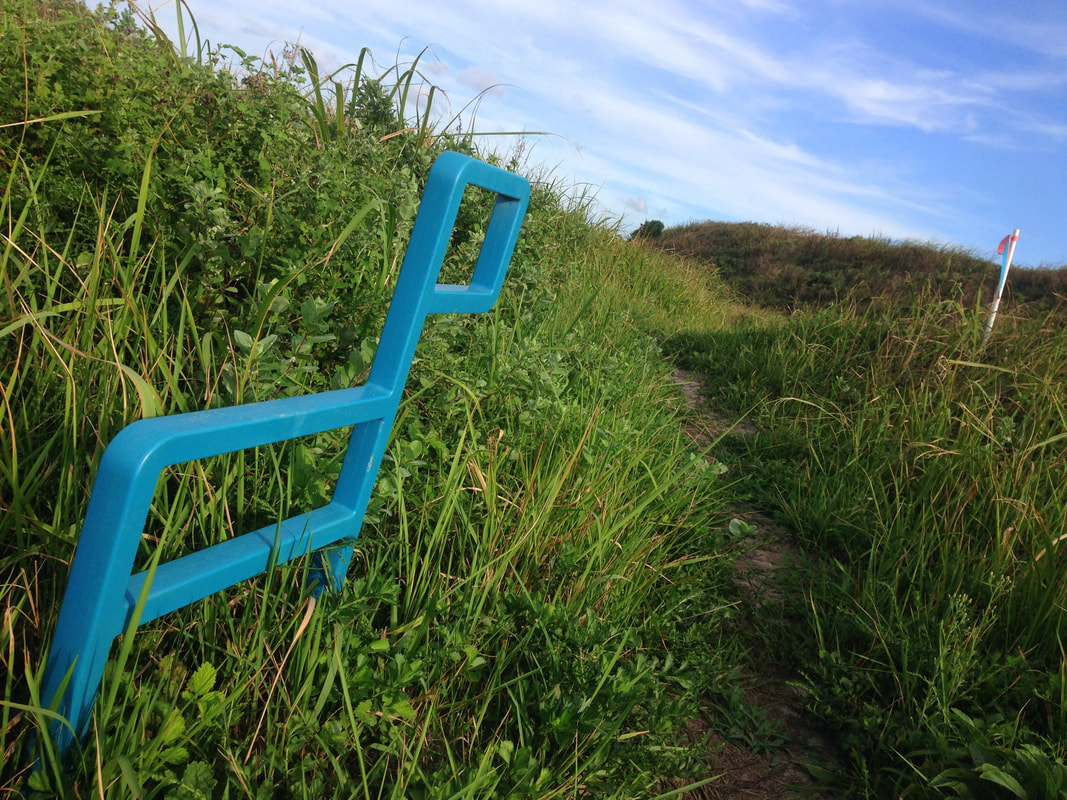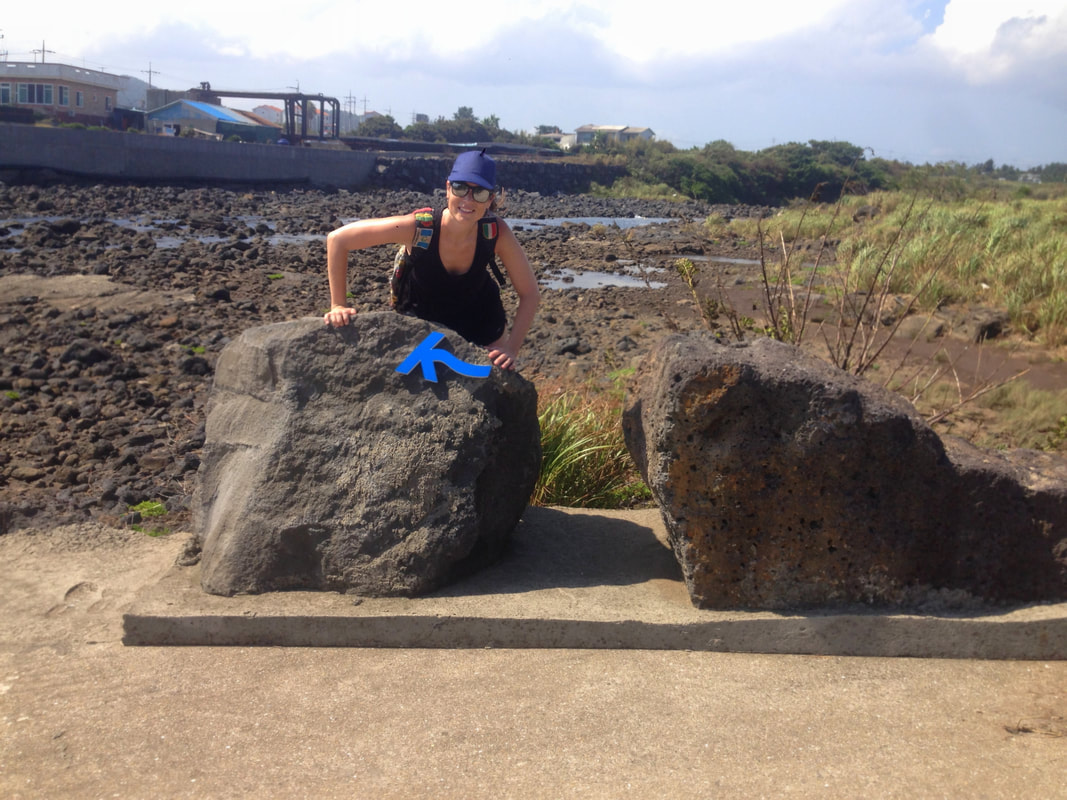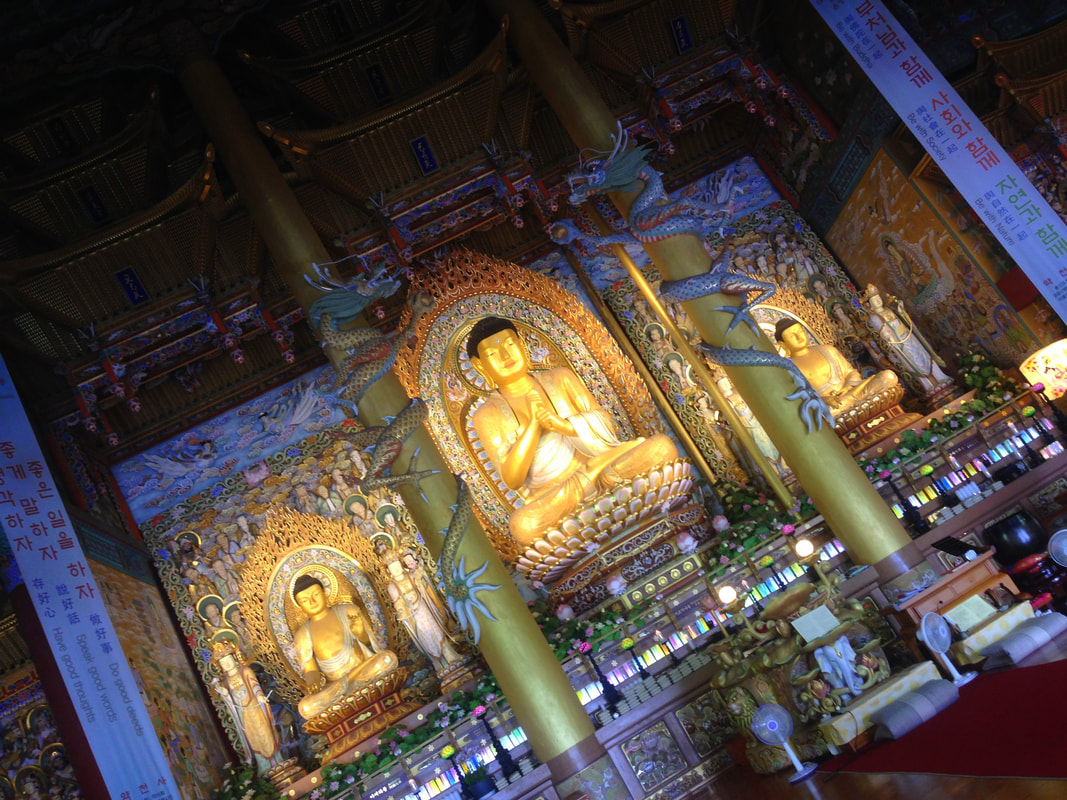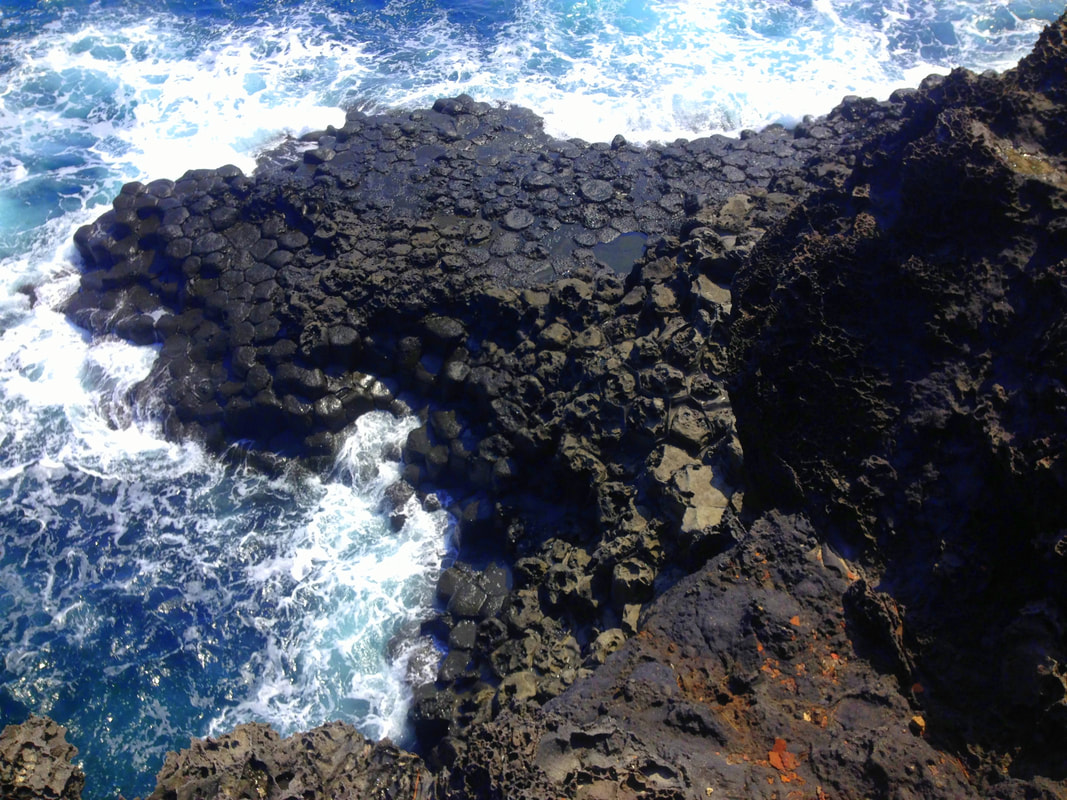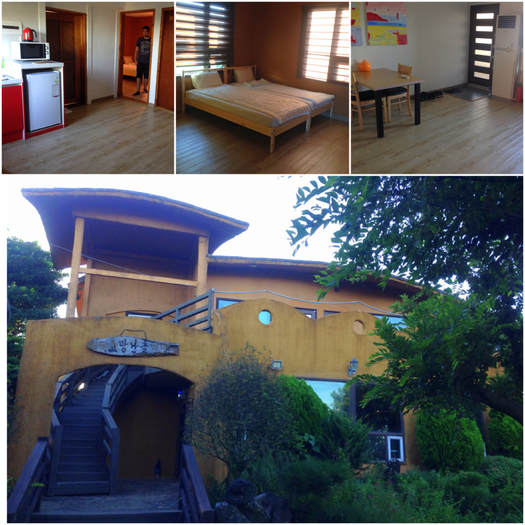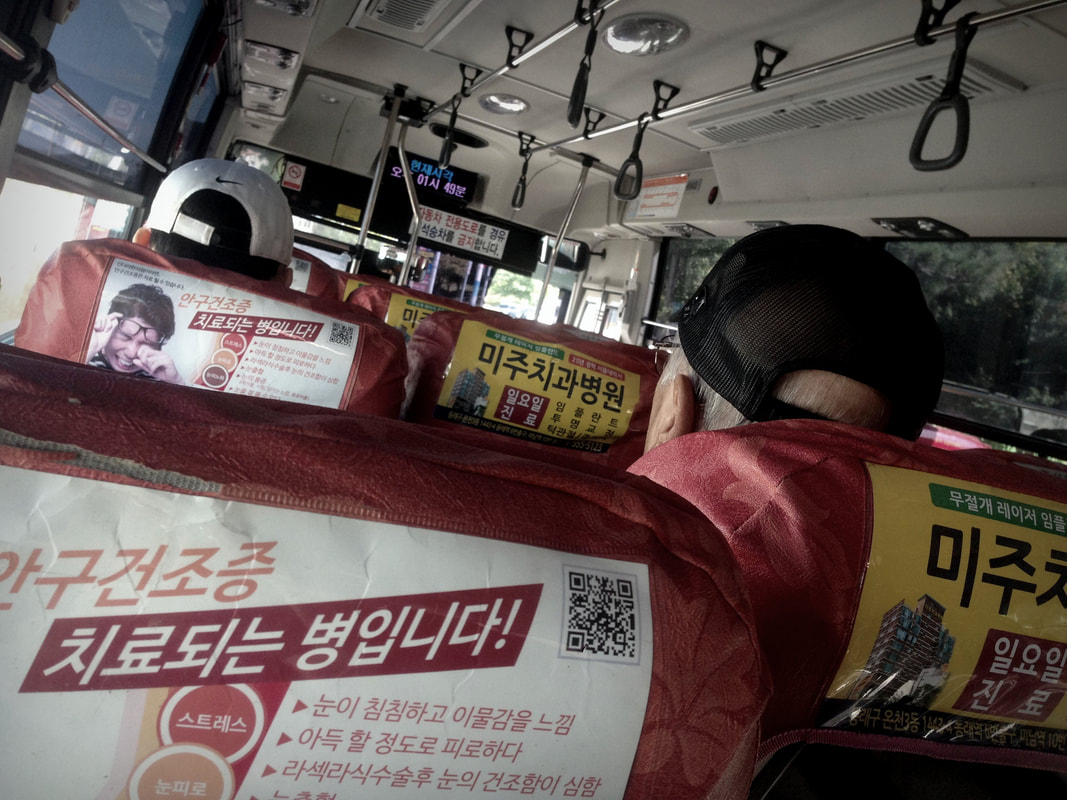Jeju Island
For budget tips & compact place-specific travel info... Download my FREE Budget Fact Sheets. You're welcome.
| Download Steph's JEJU Quick Budget Fact Sheet | |
| File Size: | 1242 kb |
| File Type: | |
Usually an unknown country unwillingly sketches a mental picture. Shout “Italy” and a sequence of pizza’s, leaning towers and heated hand movements penetrate your consciousness, whether you’ve been there or not. Randomly drop the word “India”, and there it is: cognitive images of ‘enlightened’ westerners at the feet of guru’s and swami’s, the Taj Mahal, men with moustaches and buses invisible by the swarms of people hanging on them...
... but South Korea? Hmmm. Fast internet? Tourists taking selfies, maybe?
Pretty much! But soon I learned there is so much more that defines this country and its very distinct culture.
... but South Korea? Hmmm. Fast internet? Tourists taking selfies, maybe?
Pretty much! But soon I learned there is so much more that defines this country and its very distinct culture.
It started in the airplane during my flight to Jeju Island, locally known as Jeju-do. I watched a full-grown adult woman holding a stuffed bunny. Or a child dressed like a fashionable adult. Not sure what to do with that information I walked to the toilet (in Korea usually equipped with seat warmers and anal-rinse-sprayers), where childish graphics explained to me where to drop my poo-poo. The same happened when I dried my hands, tried to find the Jeju airport bus or connected to the airport wifi: not a single item can be explained without the use of cute cartoons.
Which might come in useful in hindsight, as soon I learned I can’t read a thing (hangul replaces the alphabet) nor have the ability to communicate with a single person in this land either... English brings you nowhere in Korea, as not a living soul here speaks more than five words of it. And even if they could, I noticed I was being openly avoided or ignored by the shy and introverted Koreans, which is according to an old Lonely Planet of the ‘80ies related to their social caste system that simply doesn’t cover the existence of foreigners... right. In these first few days the closest I came to social contact was when someone accidentally bumped into me because they were buried so deep into their phones they became oblivious to reality (a very strong cultural feature - but worry not: this was about to change, Stephanie heart Koreans!).
If I wasn’t overwhelmed enough I also came to the immediate conclusion that I couldn’t even afford to be there, as South Korea is expensive... so incredibly jaw-dropping expensive!
If I wasn’t overwhelmed enough I also came to the immediate conclusion that I couldn’t even afford to be there, as South Korea is expensive... so incredibly jaw-dropping expensive!
But I straightened my shoulders and decided to make it work. Nothing is insurmountable in travel-land. I am a guest in their country, so the adaptation needs to come from my side. They don’t speak English? Fine, I’ll install the Korean Duolingo app (free), 가져와, 암캐 들아! They don’t come to me? Hell, I’ll fire my charm attack at them before they can even breathe! They think they can scare me with the prices? Budget Bucket List right at ya, here we go!
How to spend a budget holiday in Jeju: Free activities
Hallasan National Park
Surprisingly enough the island’s main attraction, Mount Hallasan and the national park around it, is entirely free of charge to enter. This impressive natural highlight not only forms the highest point of entire South Korea, it also takes a key role in local spirituality as the home of gods and spirits. No wonder it’s absolutely swamped with (local) tourists, no matter the day, no matter the season... But don’t let that stop you, as your efforts and minor annoyances will pay off.
There are five main trails to choose from, two can be combined in one day:
These two trails are the only ones that lead to the peak of Mount Hallasan, and therefore the most popular ones. I recommend to combine these into a day trip to not walk the same route twice. The easiest option is going up via the Seongpanak Trail and walking the more strenuous Gwaneumsa Trail back down. The cut-off times for these trails are 1PM (May-August), 12:30 PM (March-April & September-October) or 12PM (November-February), they won’t let you finish the hike after these times so evaluate your hiking-speed and physical condition to start in time.
How to spend a budget holiday in Jeju: Free activities
Hallasan National Park
Surprisingly enough the island’s main attraction, Mount Hallasan and the national park around it, is entirely free of charge to enter. This impressive natural highlight not only forms the highest point of entire South Korea, it also takes a key role in local spirituality as the home of gods and spirits. No wonder it’s absolutely swamped with (local) tourists, no matter the day, no matter the season... But don’t let that stop you, as your efforts and minor annoyances will pay off.
There are five main trails to choose from, two can be combined in one day:
- Gwaneumsa Trail: 8.7KM, steep, in theory 5 hours 1-way*. Starts at the northern end of the park and leads to the Mount Hallasan Peak. There’s a cheap campsite at the trail entrance. Cut-off point: Yongjingak shelter.
- Seongpanak Trail: 9.6KM, more gradual, in theory 4:30 hours 1-way*. Starts at the eastern end of the park and leads to the Mount Hallasan peak. Cut-off point: Jindallaebat shelter.
These two trails are the only ones that lead to the peak of Mount Hallasan, and therefore the most popular ones. I recommend to combine these into a day trip to not walk the same route twice. The easiest option is going up via the Seongpanak Trail and walking the more strenuous Gwaneumsa Trail back down. The cut-off times for these trails are 1PM (May-August), 12:30 PM (March-April & September-October) or 12PM (November-February), they won’t let you finish the hike after these times so evaluate your hiking-speed and physical condition to start in time.
- Eorimok Trail: 6.8KM, not too steep, in theory 3 hours 1-way*. Starts at the north-western side of the park.
- Yeongsil Trail: 5.8KM, steep parts but rather easy, in theory 2:30 hours 1-way.* Starts at the south-western side of the park.
- Donnaeko Trail: 7KM, more uneven and steep, in theory 3,5 hours 1-way*. Lesser-known trail that starts at the southern side of the park. There’s a free campsite at the entrance in the Donnaeko Valley (114 Donnaeko-ro / Sanghyo-dong).
Realize that none of these three trails lead to Mount Hallasan’s peak, they go right passed it. Nevertheless, they’re very scenic and worth walking... and Mount Hallasan is best seen right next to it, not when you’re standing on the top. The Eorimok and Yeongsil Trail connect, and with a bit of a detour you can easily reach the lesser-known and non-touristy Donnaeko Trail from both of them, so you can combine two of these three into a daytrip. At the start of the Eorimok Trail there’s also the lesser known Eoseungsaengak Trail which takes only half an hour 1-way.
* The times mentioned are as advertised by the Korean Tourism board. They strongly differ per hiker, and should be considered as some kind of a ‘worst case scenario’: the time the slowest walker of all has to take into account. I’m an experienced hiker and found I did it in exactly half of this time frame.
!!! Take the cut-off times into account, as a park ranger will literally chase you to drag you back (believe me, I tried). Except for on the Eorimok Trail, there are few water sources available, so bring enough, especially on hot and humid summer days. Jeju Island weather conditions are highly changeable and no matter the season, the top could be windy and cold. Bring clothes for all climates and don’t forget both sunscreen and a poncho.
To demonstrate my case, this was the situation on top of the Hallasan Mountain when I was there... after a sweaty summer hike full of sun:
To demonstrate my case, this was the situation on top of the Hallasan Mountain when I was there... after a sweaty summer hike full of sun:
I dedicated two full days to the Hallasan National Park and managed to check off four out of five trails. The popular route Seongpanak-Gwaneumsa combination was the hardest one, yet way easier than I expected. Up was surprisingly mellow, but the way down was steep and seemed endless, taking a hard toll on my knees, toes and concentration (but then again, I did this trail after skipping an entire night). I was told to start between 7-8AM to be in time at the check point, but in reality I could have started at 11AM and still be in time. The second day I climbed up via the Yeongsil Trail and down via the Eorimok (I planned on doing the Donnaeko, but the cut-off time had passed and I was sent away), and I still had energy for the Eoseungsaengak Trail. I found these trails offering even more spectacular views, despite the fact that it doesn’t lead to the top. All trails I did are a 50/50 combination of uneven rocky paths (which can be rather challenging and slippery after rainfall – hiking poles recommended) and easy wooden stairs, all so clearly indicated it takes special skills to get lost.
Public transport to and from the trails is existent, but not regular. Sometimes it requires a 1,5-hour wait... which is why I turned to hitchhiking.
Public transport to and from the trails is existent, but not regular. Sometimes it requires a 1,5-hour wait... which is why I turned to hitchhiking.
Olle Trails
Another amazing initiative in Jeju Hiking Land is the Olle-Trails-network encircling the island, each of them taking about 3-7 hours. Consisting of a total of 26 trails along the coast and through countryside, this is the way to discover the more hidden highlights of the island. Some parts are even wheelchair-friendly! Every route is clearly signposted with the blue and orange ribbons (each indicating a walking direction), sign-stones, plates, arrows on the ground and those on wooden poles... in short, it’s near to impossible to get lost:
Another amazing initiative in Jeju Hiking Land is the Olle-Trails-network encircling the island, each of them taking about 3-7 hours. Consisting of a total of 26 trails along the coast and through countryside, this is the way to discover the more hidden highlights of the island. Some parts are even wheelchair-friendly! Every route is clearly signposted with the blue and orange ribbons (each indicating a walking direction), sign-stones, plates, arrows on the ground and those on wooden poles... in short, it’s near to impossible to get lost:
|
If still in doubt, download the (half-Korean / half-English) Kakao Maps app, as besides bus information it discloses the Olle Trails as well. Or download the very comprehensive Olle Trail Guidebook here, also available in print:
| ||||||||
I’d like to feature four of them that I specifically recommend:
* The estimated time is 4-5 hours, but I finished in 2. Afterwards I continued with trail 1.
* There’s no charge for entering Udo Island. However, the ferry costs KRW 8,500 (2018) return and leaves every 15 minutes. A passport is necessary!
* Alternatives: Marado Island / Gapado / Wando Island.
- 1:1 Udo Island (11.3KM): Besides a captivating hiking trip, this one is special as it covers a must-see attraction. Jeju might be an island in itself, but there are numerous of smaller islets surrounding the giant, Udo being the most popular one. Although being an extension of Jeju landscape-wise, this compact little atoll has a more intimate and secluded feel to it, with a little sprinkle of that unmistakable holiday vibration. You can copy the locals and rent one of them crazy-asian-karts (some supersonic upgrade of a tuktuk), but personally I recommend following the trail leading passed stunning sights and viewpoints only reachable on foot.
* The estimated time is 4-5 hours, but I finished in 2. Afterwards I continued with trail 1.
* There’s no charge for entering Udo Island. However, the ferry costs KRW 8,500 (2018) return and leaves every 15 minutes. A passport is necessary!
* Alternatives: Marado Island / Gapado / Wando Island.
- 3 Onpyeong to Pyoseon (20.9KM): This trail gives you a choice: Discovering the stunning volcanic coast line, or deflecting into the lush countryside. There is no bad choice here. From the refreshing street art in Sincheon (the place I choose to be my home for 3,5 weeks) to the sparkling white Pyoseon Haevichi Beach, this route never disappoints.
- 8 Wolpyeong to Daepyeong (19.8km): This one is very interesting as it passes a number of famous sights, like the Yakcheonsa Temple (free entrance – temple stays paid), the Daepo Harbour (free), Jusangjeolli hexagonal lava columns (entrance), the Berinnae Oreum Observatory (free), the Yerae Eco Park (free) and the Cheonjeyeon Falls (entrance). A bit of a bummer is that after a relaxing stroll on the beach you have to walk about 5km over concrete along a busy road, as private resorts have bought up the beach and thus the access ways.
- 20 Gimnyeong to Hado (17.6KM): Locals say Jeju is the island of wind, rocks and women... and this trail is a perfect showcase of all these elements. This coastal track passes villages, countryside, weathered coast and wind turbines forming the decor of the Haenyeo’s practices: A community of aged female divers (some in their 80’s!) making a living by free diving for shellfish, forming a distinct symbol of Jeju. Another highlight is Woljeong Beach, a trendy beach town full of jar-using-hipsterbars and vintage-clothing-sheds.
Other free hiking opportunities: Halla Arboretum, Saryeoni Forest Path, Yongnuni Oreum, Sutmoreu Sún, Dongbaek Dongsan Wetland, Saebyol Oreum [links in Free Budget Fact Sheet].
Paid hikes: Jeolmul Natural Forest, Biljarim Forest.
The Islands
Besides the just mentioned Udo, Marado, Gapado and Wando Island – free, but for which a ferry fee needs to be paid in order to get there – there’s another one that requires no investment: Seoseom Island. From the vibrant city of Seogwipo, which is worth a visit in itself, you can easily cross a bridge and walk to this little abundantly green islet just off the coast. The loop-walk won’t take you more than half an hour, but will lighten up the rest of your day.
Paid hikes: Jeolmul Natural Forest, Biljarim Forest.
The Islands
Besides the just mentioned Udo, Marado, Gapado and Wando Island – free, but for which a ferry fee needs to be paid in order to get there – there’s another one that requires no investment: Seoseom Island. From the vibrant city of Seogwipo, which is worth a visit in itself, you can easily cross a bridge and walk to this little abundantly green islet just off the coast. The loop-walk won’t take you more than half an hour, but will lighten up the rest of your day.
Waterfalls
If there’s one thing Jeju has plenty, then it’s waterfalls. No need to check off every single one of them, but I would at least opt for one or two. And in that case, why not the free ones? The Cheonjiyeon Fall (not to be confused with Cheonjeyeon with an E) is located in the middle of the pleasant city of Seogwipo... Within the Geolmae Eco Park to be more precisely, a green oasis in the hustle-and-bustle of a busy urban area. Good places like this exist.
Another freebie is the Jeongbang Waterfall, the only one in Asia discharging directly into the sea, a true Korean-magnet (it's impossible to shoot a photo without hundreds of Koreans taking selfies in the background). Rumour has it you are actually supposed to pay a KRW 2,000 admission fee, but at my time of visiting there was no ticket desk to be seen.
Paid alternative: Cheonjeyeong Falls.
If there’s one thing Jeju has plenty, then it’s waterfalls. No need to check off every single one of them, but I would at least opt for one or two. And in that case, why not the free ones? The Cheonjiyeon Fall (not to be confused with Cheonjeyeon with an E) is located in the middle of the pleasant city of Seogwipo... Within the Geolmae Eco Park to be more precisely, a green oasis in the hustle-and-bustle of a busy urban area. Good places like this exist.
Another freebie is the Jeongbang Waterfall, the only one in Asia discharging directly into the sea, a true Korean-magnet (it's impossible to shoot a photo without hundreds of Koreans taking selfies in the background). Rumour has it you are actually supposed to pay a KRW 2,000 admission fee, but at my time of visiting there was no ticket desk to be seen.
Paid alternative: Cheonjeyeong Falls.
Beaches
If you’re in for a swim you came to the right place. Beware, not the entire coast is suitable for swimming, as volcanic stone is surprisingly sharp and can make some nasty cuts. Limit the dives to the pearl-white (and coal-black) beaches Jeju’s coastline is randomly dotted with. If you’re having a hard time sitting still on a towel: Jeju is big in watersports such as snorkelling, scuba-diving and kayaking.
The most popular ones: Pyoseon Haevichi, Hyeopjae, Gwakji Gwamul, Hwasun, Jungmun Saekdal, Sanhosa, Hado, Gimnyeong Seonsegi, Hamdeok, Yongmeori, Woljeong, Geumneung Eutteumwon, Sehwa, Gwangchigi. Many beaches have free camping facilities.
If you’re in for a swim you came to the right place. Beware, not the entire coast is suitable for swimming, as volcanic stone is surprisingly sharp and can make some nasty cuts. Limit the dives to the pearl-white (and coal-black) beaches Jeju’s coastline is randomly dotted with. If you’re having a hard time sitting still on a towel: Jeju is big in watersports such as snorkelling, scuba-diving and kayaking.
The most popular ones: Pyoseon Haevichi, Hyeopjae, Gwakji Gwamul, Hwasun, Jungmun Saekdal, Sanhosa, Hado, Gimnyeong Seonsegi, Hamdeok, Yongmeori, Woljeong, Geumneung Eutteumwon, Sehwa, Gwangchigi. Many beaches have free camping facilities.
Museums
The last thing you probably think about when hearing the word ‘tropical island’ is a museum, but yet it could be a nice cultural distraction in between all the snorkeling, kayaking and hiking. Especially if it’s free! The Jeju National Museum gives you a feel of the historical and cultural background of the island without ever inducing a yawn. The O’sulloc Tea Museum is another free must-see, especially if you happen to be British.
There are also tons of paid museums available, ranging from ‘hmmm this might be interesting’ (Jeju Folk Museum / Loveland) to ‘what the hell is this necessary for’ (Teddy Bear Museum / Believe it or Not Museum). Prices lie around KRW 10,000-20,000 so choose wisely! Find a list here.
The last thing you probably think about when hearing the word ‘tropical island’ is a museum, but yet it could be a nice cultural distraction in between all the snorkeling, kayaking and hiking. Especially if it’s free! The Jeju National Museum gives you a feel of the historical and cultural background of the island without ever inducing a yawn. The O’sulloc Tea Museum is another free must-see, especially if you happen to be British.
There are also tons of paid museums available, ranging from ‘hmmm this might be interesting’ (Jeju Folk Museum / Loveland) to ‘what the hell is this necessary for’ (Teddy Bear Museum / Believe it or Not Museum). Prices lie around KRW 10,000-20,000 so choose wisely! Find a list here.
Cheap Activities (KRW 2,000 or less)
Alright, enough stuff to do without spending a dime! But also the few paid outings won’t break the bank. Jeju generally charges a KRW 2,000 flat admission fee (2018) for viewing its natural treasures, which comes down to about €1,50. A quick overview:
Everything Lava
Jeju is by all means a volcanic island and every single part of its landscape is a quick reminder. Besides the obvious must-see of the Hallasan Crater (South Korea’s highest point – free entry), make sure you also visit the extensive underground lava-tunnel-network of the Manjanggul Cave, recognized as UNESCO World Heritage, or pay a visit to the Sangumburi Crater.
Alright, enough stuff to do without spending a dime! But also the few paid outings won’t break the bank. Jeju generally charges a KRW 2,000 flat admission fee (2018) for viewing its natural treasures, which comes down to about €1,50. A quick overview:
Everything Lava
Jeju is by all means a volcanic island and every single part of its landscape is a quick reminder. Besides the obvious must-see of the Hallasan Crater (South Korea’s highest point – free entry), make sure you also visit the extensive underground lava-tunnel-network of the Manjanggul Cave, recognized as UNESCO World Heritage, or pay a visit to the Sangumburi Crater.
Another remarkable landmark that won’t fail to impress you is the well-visited Seongsan Ilchulbong Peak, a dormant volcanic cone also known as the ‘Sunrise Peak’. Honestly, I couldn’t be arsed to go at sunrise (any idea how early that is?), but I can confirm that even during daytime this sight will leave you speechless. Literally, as that is some serious stairs-climbing awaiting you. If you happen to be there during New Years Eve, definitely go and have a gander, as that’s what the locals traditionally do to start their years.
Another volcanic cheapo on the budget bucket list is the Daepo Jusangjeolli Cliff (reached by Olle Trail 8). The oddly-shaped stone pillars were formed when the lava streamed straight out of Mount Hallasan into the Jungmun Sea, abruptly cooled down by the frigid waves. An unearthly sight:
How can I eat without going bankrupt?
You’re staring at that delicious menu and disappointment takes over... how the hell are you going to afford that?? Sell a kidney? Exchange your child?
The cheapest way to go is self-catering. Surprisingly enough markets won’t give you much of a bargain in Jeju (unlike basically everywhere else in the world), but the giant department stores do. Make sure that during your Jeju island tour you make a quick pittstop at either E-Mart (Jeju / Seogwipo) or Lotte (Jeju) to stock up on their house brands, and if you have the time: shop around different smaller supermarkets to purchase their promotions. Prices vary widely!
You’re staring at that delicious menu and disappointment takes over... how the hell are you going to afford that?? Sell a kidney? Exchange your child?
The cheapest way to go is self-catering. Surprisingly enough markets won’t give you much of a bargain in Jeju (unlike basically everywhere else in the world), but the giant department stores do. Make sure that during your Jeju island tour you make a quick pittstop at either E-Mart (Jeju / Seogwipo) or Lotte (Jeju) to stock up on their house brands, and if you have the time: shop around different smaller supermarkets to purchase their promotions. Prices vary widely!
The Maeil Olle Market gives an engaging cultural insight in Korean culture... but I couldn’t afford to buy anything there!
Does free accommodation exist in Jeju?
The answer to that is short and surprising: Yes, it does. There are a handful of free campsites on the island, such as the Hyeopjae Beach Campsite, Pyoseon Beach Campsite and Donnaeko Campsite close to the Hallasan National Park. Others are only KRW 1,000 – 3,000 (have a look at Jeju Weekly), so even the skint ones among us won’t have to panic.
Couchsurfing is quite alive in South Korea, and even more so in Jeju. At the time of checking there are 1174 hosts on the island, so surely one will be willing to take you in (for free!).
If you’re keen to book a Jeju hotel, hostel or guesthouse, at least an adjoining gym doesn’t have to be a prime factor: Free fitness equipment is found at every park and beachside!
Does free accommodation exist in Jeju?
The answer to that is short and surprising: Yes, it does. There are a handful of free campsites on the island, such as the Hyeopjae Beach Campsite, Pyoseon Beach Campsite and Donnaeko Campsite close to the Hallasan National Park. Others are only KRW 1,000 – 3,000 (have a look at Jeju Weekly), so even the skint ones among us won’t have to panic.
Couchsurfing is quite alive in South Korea, and even more so in Jeju. At the time of checking there are 1174 hosts on the island, so surely one will be willing to take you in (for free!).
If you’re keen to book a Jeju hotel, hostel or guesthouse, at least an adjoining gym doesn’t have to be a prime factor: Free fitness equipment is found at every park and beachside!
How to get around on the cheap / for free?
The answer you probably heard before is: “rent a car”. True, if you’re travelling with a travel company of 2+ people and have limited time to see as much as possible, this is 100% the best option (there are even charging stations for electronic vehicles!). Also sharing a cab is affordable when traveling with a group, as costs can be split and it beats the hell out a bus. The reason for that is that Jeju’s public transport network sucks balls. I can honestly say I spent more time waiting on buses than actually enjoying the attractions where they (eventually) brought me to. Another downside is that there’s hardly any information available in English, you can’t ask anyone either for the same reasons and apps such as Moovit and Google Maps do not work here.
However, if you’re on a budget this is pretty much your only option.
BUS TRANSPORT: I lived the nightmare to tell the story, so let me give you a head start:
The answer you probably heard before is: “rent a car”. True, if you’re travelling with a travel company of 2+ people and have limited time to see as much as possible, this is 100% the best option (there are even charging stations for electronic vehicles!). Also sharing a cab is affordable when traveling with a group, as costs can be split and it beats the hell out a bus. The reason for that is that Jeju’s public transport network sucks balls. I can honestly say I spent more time waiting on buses than actually enjoying the attractions where they (eventually) brought me to. Another downside is that there’s hardly any information available in English, you can’t ask anyone either for the same reasons and apps such as Moovit and Google Maps do not work here.
However, if you’re on a budget this is pretty much your only option.
BUS TRANSPORT: I lived the nightmare to tell the story, so let me give you a head start:
- Buses come in three colours: Blue, red and green. The blue buses generally go most frequently, but tend to stop everywhere so take a bit longer. The red ones have fewer stops so they go faster, but generally go only once every one or two hours. The green ones go more into the villages and countryside, but go as infrequent as the red ones.
- The blue and green ones cost KRW 1,200 (2018) per ride, the red ones charge per distance (and the airport bus is more expensive), you can pay in coins. Even better, buy a T-Money Card in one of the minimarkets (CU / GS25) and charge it... it’s a small initial investment, but every ride has a KRW 50 discount, plus two free transfers if you change buses within 40 minutes (if you change into a red bus extra charges will apply). The T-Money Card can also be used for city buses in the rest of Korea.
- As there is no properly working Google Maps (they’ll give you incorrect routes) nor Moovit, the Naver and/or Kakao Maps apps are the best waysto go. It’s mainly in Korean, but recognizes place names typed in the alphabet and has a map-pin-function.
- Buses all have perfectly working wifi connections. Sweet!
Cycling: Biking is a perfect and free way to get around... at least, if you bring your own bicycle, as rental prices are shocking. Jeju has a profound network of bicycle lanes and even air-pump-stations!
Hitchhiking: Unlike you might expect from those shy Koreans, hitchhiking is ridiculously easy. I gave my thumbs a good go and every single time the very first car abruptly stopped. In fact, people even brought me to places they didn’t even need to go to themselves, just to help a stranger out.
After all it really is just a language barrier that separates, not an unwillingness to connect.
Before I even noticed I had fallen in love with Korea. Those amazing, introverted and happy beings that will do anything to help you, share their rice wine when you finished hiking and burst out in giggles when asking you to pose for their selfie. All of a sudden I didn’t want to leave.
Hitchhiking: Unlike you might expect from those shy Koreans, hitchhiking is ridiculously easy. I gave my thumbs a good go and every single time the very first car abruptly stopped. In fact, people even brought me to places they didn’t even need to go to themselves, just to help a stranger out.
After all it really is just a language barrier that separates, not an unwillingness to connect.
Before I even noticed I had fallen in love with Korea. Those amazing, introverted and happy beings that will do anything to help you, share their rice wine when you finished hiking and burst out in giggles when asking you to pose for their selfie. All of a sudden I didn’t want to leave.
In order to support the travelers’ community, I spend many hours per week to adequately document all information and advices for prospective visitors, accompanied by a (hopefully) entertaining insight into my personal observations and experiences. This service is and will remain free. However, if you voluntarily want to make a contribution and support my travels and thus the creation of new stories and information supply, here is the button you’re looking for:
Related:
- Travel more in South Korea: Busan, Jirisan NP & Surroundings, Andong, Taebaek, Gyeongju, Gangneung, Seoraksan NP & Odaesan NP & Seoul
- 13 Strange Observations of South Korea
- A little sneak-peek into North Korea!
- Make a Malaysia roundtrip: Kuala Lumpur, the Cameron Highlands, Ipoh, Taman Negara, Penang, Tioman Island, Kuching, Melaka, Miri, and Sabah!
- Crossing the border to Singapore... or better not?
- The Philippines: Yay or nay?
- Discover the richness of Brunei in Bandar Seri Begawan!
- Malaysia's hottest hiking spots: visit Taman Negara, Cameron Highlands, Penang, Miri and Kuching!
- Oceania's walking walhalla: Travel New Zealand!
- When hiking the mountains turns into a memorable disaster: Trekking the Andes, Peru
- Lush jungle treks full of wildlife: Discover Monteverde, Costa Rica
- European hiking adventures: Mols Bjerge National Park, Denmark
- Jordan, a destination on the rise: Extensive guides to Petra, Amman and Wadi Rum
- Hiking Poland's longest mountain trail (550km) with a tent: Glowny Szlak Beskidzki - check the reports here!
- Walk like a pilgrim! 6 weeks on the Camino Frances towards Santiago de Compostela / Finisterre (900km) - check the reports here!
- Check out Budget Bucket List's FAVORITE HIKING DESTINATIONS worldwide!
- Travel more in South Korea: Busan, Jirisan NP & Surroundings, Andong, Taebaek, Gyeongju, Gangneung, Seoraksan NP & Odaesan NP & Seoul
- 13 Strange Observations of South Korea
- A little sneak-peek into North Korea!
- Make a Malaysia roundtrip: Kuala Lumpur, the Cameron Highlands, Ipoh, Taman Negara, Penang, Tioman Island, Kuching, Melaka, Miri, and Sabah!
- Crossing the border to Singapore... or better not?
- The Philippines: Yay or nay?
- Discover the richness of Brunei in Bandar Seri Begawan!
- Malaysia's hottest hiking spots: visit Taman Negara, Cameron Highlands, Penang, Miri and Kuching!
- Oceania's walking walhalla: Travel New Zealand!
- When hiking the mountains turns into a memorable disaster: Trekking the Andes, Peru
- Lush jungle treks full of wildlife: Discover Monteverde, Costa Rica
- European hiking adventures: Mols Bjerge National Park, Denmark
- Jordan, a destination on the rise: Extensive guides to Petra, Amman and Wadi Rum
- Hiking Poland's longest mountain trail (550km) with a tent: Glowny Szlak Beskidzki - check the reports here!
- Walk like a pilgrim! 6 weeks on the Camino Frances towards Santiago de Compostela / Finisterre (900km) - check the reports here!
- Check out Budget Bucket List's FAVORITE HIKING DESTINATIONS worldwide!




